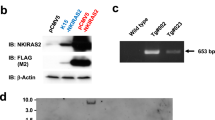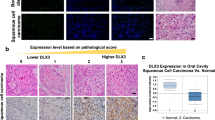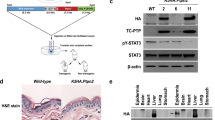Abstract
In recent years a growth inhibitory role in skin for the Rel/NF-κB transcription factors has been established, and the block of Rel/NF-κB signaling results in rapid development of spontaneous skin cancer. The molecular mechanism underlying tumor development is however unknown. In the present study, we show that inhibition of NF-κB signaling in mouse skin by targeted expression of degradation resistant IκB-α generates transgenic keratinocytes unable to arrest the cell cycle in response to DNA damage induced by γ-radiation. The results indicate that transgenic keratinocytes have a defect at the G1-S checkpoint whereas the G2-M checkpoint response was found to be intact. However, transgenic keratinocytes still respond by induction of the cyclin dependent kinase inhibitor p21Cip1/Waf after exposure to γ-radiation. In the spontaneous skin tumors that develop in transgenic mice no mutations were found in the Ha-ras or p53 gene, suggesting that inhibition of NF-κB signaling in skin can induce cancer development independently of initiating mutations in the Ha-ras gene or additional mutations in the p53 gene. These findings demonstrate an involvement of NF-κB signaling in the DNA damage response and cell cycle checkpoint control in the skin.
This is a preview of subscription content, access via your institution
Access options
Subscribe to this journal
Receive 50 print issues and online access
$259.00 per year
only $5.18 per issue
Buy this article
- Purchase on Springer Link
- Instant access to full article PDF
Prices may be subject to local taxes which are calculated during checkout





Similar content being viewed by others
References
Ahmed NU, Ueda M, Ichihashi M . 1997 J. Cutan. Pathol. 24: 223–227
Amundson SA, Myers TG, Fornace Jr AJ . 1998 Oncogene 17: 3287–3299
Auer GU, Heselmeyer KM, Steinbeck RG, Munck-Wikland E, Zetterberg AD . 1994 Virchows Arch. 424: 343–347
Bartek J, Lukas J . 2001 FEBS Letts. 490: 117–122
Bash J, Zong WX, Gelinas C . 1997 Mol. Cell. Biol. 17: 6526–6536
Brash DE, Rudolph JA, Simon JA, Lin A, McKenna GJ, Baden HP, Halperin AJ, Ponten J . 1991 Proc. Natl. Acad. Sci. USA 88: 10124–10128
Campbell C, Quinn AG, Rees JL . 1993 Br. J. Dermatol. 128: 111–114
Chen E, Li CC . 1998 Biochem. Biophys. Res. Commun. 249: 728–734
Coleman WB, Tsongalis GJ . 1995 Clin. Chem. 41: 644–657
Devereux TR, Foley JF, Maronpot RR, Kari F, Anderson MW . 1993 Carcinogenesis 14: 795–801
Doffinger R, Smahi A, Bessia C, Geissmann F, Feinberg J, Durandy A, Bodemer C, Kenwrick S, Dupuis-Girod S, Blanche S, Wood P, Rabia SH, Headon DJ, Overbeek PA, Le Deist F, Holland SM, Belani K, Kumararatne DS, Fischer A, Shapiro R, Conley ME, Reimund E, Kalhoff H, Abinun M, Munnich A, Israel A, Courtois G, Casanova JL . 2001 Nat. Genet. 27: 277–285
Hanahan D, Weinberg RA . 2000 Cell 100: 57–70
Hegi ME, Soderkvist P, Foley JF, Schoonhoven R, Swenberg JA, Kari F, Maronpot R, Anderson MW, Wiseman RW . 1993 Carcinogenesis 14: 803–810
Hendzel MJ, Wei Y, Mancini MA, Van Hooser A, Ranalli T, Brinkley BR, Bazett-Jones DP, Allis CD . 1997 Chromosoma 106: 348–360
Hinz M, Krappmann D, Eichten A, Heder A, Scheidereit C, Strauss M . 1999 Mol. Cell. Biol. 19: 2690–2698
Hu Y, Baud V, Delhase M, Zhang P, Deerinck T, Ellisman M, Johnson R, Karin M . 1999 Science 284: 316–320
Hu Y, Baud V, Oga T, Kim KI, Yoshida K, Karin M . 2001 Nature 410: 710–714
Inohara S, Kitagawa K, Kitano Y . 1996 Dermatology 192: 94–98
Karin M, Ben-Neriah Y . 2000 Annu. Rev. Immunol. 18: 621–663
Korstanje MJ, Bessems PJ . 1991 Dermatologica 183: 234–236
Landy SJ, Donnai D . 1993 J. Med. Genet. 30: 53–59
Larner JM, Lee H, Hamlin JL . 1994 Mol. Cell. Biol. 14: 1901–1908
Li Q, Lu Q, Hwang JY, Buscher D, Lee KF, Izpisua-Belmonte JC, Verma IM . 1999 Genes Dev. 13: 1322–1328
Makris C, Godfrey VL, Krahn-Senftleben G, Takahashi T, Roberts JL, Schwarz T, Feng L, Johnson RS, Karin M . 2000 Mol. Cell 5: 969–979
Matsuta M, Kon S, Sasaki K . 1997 J. Dermatol. Sci. 14: 233–239
McGregor JM, Yu CC, Dublin EA, Levison DA, MacDonald DM . 1992 Br. J. Dermatol. 127: 463–469
Mitsunaga SI, Zhang SY, Ruggeri BA, Gimenez-Conti I, Robles AI, Conti CJ, Klein-Szanto AJ . 1995 Carcinogenesis 16: 1629–1635
Pahl HL . 1999 Oncogene 18: 6853–6866
Perkins ND, Felzien LK, Betts JC, Leung K, Beach DH, Nabel GJ . 1997 Science 275: 523–527
Pierceall WE, Goldberg LH, Tainsky MA, Mukhopadhyay T, Ananthaswamy HN . 1991 Mol. Carcinog. 4: 196–202
Poon RY, Hunter T . 1998 Oncogene 16: 1333–1343
Quintanilla M, Brown K, Ramsden M, Balmain A . 1986 Nature 322: 78–80
Ren ZP, Hedrum A, Ponten F, Nister M, Ahmadian A, Lundeberg J, Uhlen M, Ponten J . 1996a Oncogene 12: 765–773
Ren ZP, Ponten F, Nister M, Ponten J . 1996b Int. J. Cancer 69: 174–179
Ro YS, Cooper PN, Lee JA, Quinn AG, Harrison D, Lane D, Horne CH, Rees JL, Angus B . 1993 Br. J. Dermatol. 128: 237–241
Robles AI, Conti CJ . 1995 Carcinogenesis 16: 781–786
Robles AI, Larcher F, Whalin RB, Murillas R, Richie E, Gimenez-Conti IB, Jorcano JL, Conti CJ . 1996 Proc. Natl. Acad. Sci. USA 93: 7634–7638
Robles AI, Rodriguez-Puebla ML, Glick AB, Trempus C, Hansen L, Sicinski P, Tennant RW, Weinberg RA, Yuspa SH, Conti CJ . 1998 Genes Dev. 12: 2469–2474
Rumsby G, Carter RL, Gusterson BA . 1990 Br. J. Cancer 61: 365–368
Sakai H, Minami M, Satoh E, Matsuo S, Iizuka H . 2000 Dermatology 200: 258–261
Schluter C, Duchrow M, Wohlenberg C, Becker MH, Key G, Flad HD, Gerdes J . 1993 J. Cell Biol. 123: 513–522
Schmidt-Supprian M, Bloch W, Courtois G, Addicks K, Israel A, Rajewsky K, Pasparakis M . 2000 Mol. Cell 5: 981–992
Seitz CS, Deng H, Hinata K, Lin Q, Khavari PA . 2000 Cancer Res. 60: 4085–4092
Seitz CS, Lin Q, Deng H, Khavari PA . 1998 Proc. Natl. Acad. Sci. USA 95: 2307–2312
Sherr CJ, Roberts JM . 1999 Genes Dev. 13: 1501–1512
Smahi A, Courtois G, Vabres P, Yamaoka S, Heuertz S, Munnich A, Israel A, Heiss NS, Klauck SM, Kioschis P, Wiemann S, Poustka A, Esposito T, Barado T, Gianfrancesco F, Ciccodicola A, D'Urso M, Woffendin H, Jakins T, Donnai D, Stewart H, Kenwrick SJ, Aradhya S, Yamagata T, Levy M, Lewis RA, Nelson DL . 2000 Nature 405: 466–472
Song S, Lambert PF . 1999 Am. J. Pathol. 155: 1121–1127
Sutter C, Strickland PT, Mukhtar H, Agarwal R, Winter H, Schweizer J . 1993 Mol. Carcinog. 8: 13–19
Takeda K, Takeuchi O, Tsujimura T, Itami S, Adachi O, Kawai T, Sanjo H, Yoshikawa K, Terada N, Akira S . 1999 Science 284: 313–316
Tong Y, Smith MA, Tucker SB . 1997 J. Toxicol. Env. Health. 51: 219–234
Topley GI, Okuyama R, Gonzales JG, Conti C, Dotto GP . 1999 Proc. Natl. Acad. Sci. USA 96: 9089–9094
Tron VA, Tang L, Yong WP, Trotter MJ . 1996 Am. J. Pathol. 149: 1139–1146
van der Schroeff JG, Evers LM, Boot AJ, Bos JL . 1990 J. Invest. Dermatol. 94: 423–425
van Hogerlinden M, Rozell BL, Ahrlund-Richter L, Toftgard R . 1999 Cancer Res. 59: 3299–3303
Webster GA, Perkins ND . 1999 Mol. Cell. Biol. 19: 3485–3495
Weinberg WC, Fernandez-Salas E, Morgan DL, Shalizi A, Mirosh E, Stanulis E, Deng C, Hennings H, Yuspa SH . 1999 Cancer Res. 59: 2050–2054
Xie G, Habbersett RC, Jia Y, Peterson SR, Lehnert BE, Bradbury EM, D'Anna JA . 1998 Oncogene 16: 721–736
Zhou BP, Liao Y, Xia W, Spohn B, Lee MH, Hung MC . 2001 Nat. Cell. Biol. 3: 245–252
Zonana J, Elder ME, Schneider LC, Orlow SJ, Moss C, Golabi M, Shapira SK, Farndon PA, Wara DW, Emmal SA, Ferguson BM . 2000 Am. J. Hum. Genet. 67: 1555–1562
Acknowledgements
We thank the Unit for Embryology and Genetics for generation and maintenance of transgenic mice, B Sundelin for technical assistance, T Skarin for tumor samples and P Söderkvist for primers used in mutation analysis. This work was supported by grants from the Swedish Cancer Fund, the Swedish Radiation Protection Institute, the Swedish Society for Medical Research and Robert Lundbergs Minnesfond.
Author information
Authors and Affiliations
Corresponding author
Rights and permissions
About this article
Cite this article
van Hogerlinden, M., Auer, G. & Toftgård, R. Inhibition of Rel/Nuclear Factor-κB signaling in skin results in defective DNA damage-induced cell cycle arrest and Ha-ras- and p53-independent tumor development. Oncogene 21, 4969–4977 (2002). https://doi.org/10.1038/sj.onc.1205620
Received:
Revised:
Accepted:
Published:
Issue Date:
DOI: https://doi.org/10.1038/sj.onc.1205620
Keywords
This article is cited by
-
Sirtuin1 (SIRT1) is involved in the anticancer effect of black raspberry anthocyanins in colorectal cancer
European Journal of Nutrition (2023)
-
Epigenetic silencing of JAM3 promotes esophageal cancer development by activating Wnt signaling
Clinical Epigenetics (2022)
-
Inhibition of nuclear factor-kappa B enhances the tumor growth of ovarian cancer cell line derived from a low-grade papillary serous carcinoma in p53-independent pathway
BMC Cancer (2016)
-
The detective, prognostic, and predictive value of DNA methylation in human esophageal squamous cell carcinoma
Clinical Epigenetics (2016)
-
The c-Rel subunit of NF-κB is a crucial regulator of phenotype and motility of HaCaT keratinocytes
Archives of Dermatological Research (2015)



